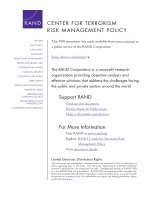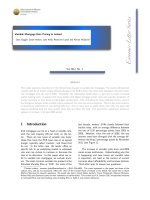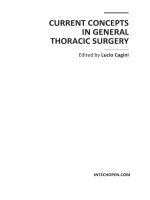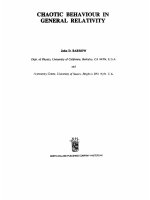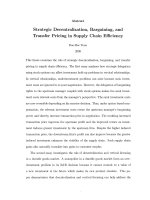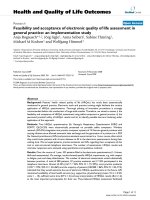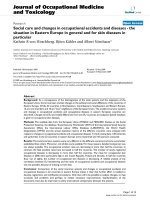Pricing in general insurance
Bạn đang xem bản rút gọn của tài liệu. Xem và tải ngay bản đầy đủ của tài liệu tại đây (5.3 MB, 564 trang )
PRICING IN
GENERAL
INSURANCE
PRICING IN
GENERAL
INSURANCE
Pietro Parodi
CRC Press
Taylor & Francis Group
6000 Broken Sound Parkway NW, Suite 300
Boca Raton, FL 33487-2742
© 2015 by Taylor & Francis Group, LLC
CRC Press is an imprint of Taylor & Francis Group, an Informa business
No claim to original U.S. Government works
Version Date: 20140626
International Standard Book Number-13: 978-1-4665-8148-7 (eBook - PDF)
This book contains information obtained from authentic and highly regarded sources. Reasonable efforts have been
made to publish reliable data and information, but the author and publisher cannot assume responsibility for the validity of all materials or the consequences of their use. The authors and publishers have attempted to trace the copyright
holders of all material reproduced in this publication and apologize to copyright holders if permission to publish in this
form has not been obtained. If any copyright material has not been acknowledged please write and let us know so we may
rectify in any future reprint.
Except as permitted under U.S. Copyright Law, no part of this book may be reprinted, reproduced, transmitted, or utilized in any form by any electronic, mechanical, or other means, now known or hereafter invented, including photocopying, microfilming, and recording, or in any information storage or retrieval system, without written permission from the
publishers.
For permission to photocopy or use material electronically from this work, please access www.copyright.com (http://
www.copyright.com/) or contact the Copyright Clearance Center, Inc. (CCC), 222 Rosewood Drive, Danvers, MA 01923,
978-750-8400. CCC is a not-for-profit organization that provides licenses and registration for a variety of users. For
organizations that have been granted a photocopy license by the CCC, a separate system of payment has been arranged.
Trademark Notice: Product or corporate names may be trademarks or registered trademarks, and are used only for
identification and explanation without intent to infringe.
Visit the Taylor & Francis Web site at
and the CRC Press Web site at
To my parents, for their unfailing support and patience over the years;
to my sister, for her constant encouragement;
and to Vincent, for his lasting and undiminishing intellectual influence.
Contents
Preface.......................................................................................................................................... xxiii
Acknowledgements.................................................................................................................... xxv
Section I Introductory Concepts
1. Pricing Process: A Gentle Start.............................................................................................3
1.1 An Elementary Pricing Example................................................................................. 3
1.1.1 Risk Costing (Gross)......................................................................................... 5
1.1.1.1 Adjusting for ‘Incurred but Not Reported’ Claims......................5
1.1.1.2 Adjusting for Claims Inflation........................................................6
1.1.1.3 Adjusting for Exposure Changes.................................................... 7
1.1.1.4 Adjusting for Other Risk-Profile Changes..................................... 9
1.1.1.5 Adjusting for ‘Incurred but Not Enough Reserved’ Claims....... 9
1.1.1.6 Changes for Cover/Legislation..................................................... 10
1.1.1.7 Other Corrections............................................................................ 10
1.1.2 Risk Costing (Ceded)...................................................................................... 11
1.1.3 Determining the Technical Premium.......................................................... 11
1.1.3.1 Loading for Costs............................................................................ 11
1.1.3.2 Discounting for Investment Income............................................. 11
1.1.3.3 Loading for Capital/Profit............................................................. 12
1.1.4 Commercial Considerations and the Actual Premium............................. 12
1.1.5 Limitations of This Elementary Pricing Example...................................... 13
1.2 High-Level Pricing Process........................................................................................ 13
1.3Questions....................................................................................................................... 14
2. Insurance and Reinsurance Products................................................................................ 17
2.1 Classification of General Insurance Products: General Ideas................................ 17
2.2 Products by Category of Cover.................................................................................. 18
2.2.1 Property Insurance......................................................................................... 18
2.2.1.1 Legal Framework............................................................................. 18
2.2.1.2 Pricing Characteristics.................................................................... 19
2.2.1.3 Examples of Property Policies....................................................... 20
2.2.2 Liability Insurance.......................................................................................... 20
2.2.2.1 Legal Framework............................................................................. 20
2.2.2.2 Pricing Characteristics....................................................................22
2.2.2.3 Examples of Liability Insurance...................................................22
2.2.3 Financial Loss Insurance............................................................................... 23
2.2.3.1Examples........................................................................................... 23
2.2.3.2 Pricing Characteristics.................................................................... 23
2.2.4 Fixed Benefits Insurance................................................................................ 23
2.2.4.1Examples........................................................................................... 23
2.2.4.2 Pricing Characteristics.................................................................... 23
2.2.5 ‘Packaged’ Products........................................................................................ 24
vii
viii
Contents
2.3
Products by Type of Customer................................................................................... 24
2.3.1 Personal Lines................................................................................................. 24
2.3.1.1Examples........................................................................................... 24
2.3.1.2 Pricing Characteristics.................................................................... 24
2.3.2 Commercial Lines........................................................................................... 25
2.3.2.1Examples........................................................................................... 25
2.3.2.2 Pricing Characteristics.................................................................... 26
2.3.3Reinsurance..................................................................................................... 26
2.3.3.1Examples........................................................................................... 26
2.3.3.2 Pricing Characteristics.................................................................... 27
2.4 Prudential Regulation Authority Classification...................................................... 27
2.5 Other Classification Schemes..................................................................................... 38
2.6 Non-Extant Products................................................................................................... 38
2.7Questions....................................................................................................................... 38
3. The Policy Structure............................................................................................................. 41
3.1 Personal Lines............................................................................................................... 41
3.1.1 Purpose of the Excess Amount.....................................................................42
3.1.2 Purpose of the Limit.......................................................................................43
3.2 Commercial Lines........................................................................................................43
3.2.1 Policy Bases......................................................................................................43
3.2.1.1 Occurrence Basis.............................................................................43
3.2.1.2 Claims-Made Basis..........................................................................43
3.2.1.3 Other Bases......................................................................................44
3.2.2 Basic Policy Structure.....................................................................................44
3.2.2.1 Each-and-Every-Loss Deductible..................................................44
3.2.2.2 Annual Aggregate Deductible......................................................44
3.2.2.3 Each-and-Every-Loss Limit............................................................ 45
3.2.3 Other Coverage Modifiers............................................................................. 49
3.2.3.1 Non-Ranking Each-and-Every-Loss Deductible......................... 49
3.2.3.2 Residual Each-and-Every-Loss Deductible.................................. 49
3.2.3.3 Quota Share...................................................................................... 49
3.2.3.4 Yet-More-Exotic Coverage Modifiers............................................ 50
3.3Reinsurance.................................................................................................................. 50
3.3.1 Policy Bases...................................................................................................... 50
3.3.1.1 Losses Occurring During.............................................................. 50
3.3.1.2 Risk Attaching During................................................................... 50
3.3.1.3 Claims Made.................................................................................... 51
3.3.2 Non-Proportional Reinsurance..................................................................... 51
3.3.2.1 Risk Excess of Loss.......................................................................... 51
3.3.2.2 Aggregate Excess of Loss............................................................... 55
3.3.2.3 Catastrophe Excess of Loss............................................................ 55
3.3.2.4 Stop Loss Reinsurance.................................................................... 57
3.3.3 Proportional Reinsurance.............................................................................. 58
3.3.3.1 Quota Share...................................................................................... 58
3.3.3.2 Surplus Reinsurance....................................................................... 58
3.4Questions....................................................................................................................... 59
Contents
ix
4. The Insurance Markets......................................................................................................... 61
4.1 Major Participants in the Insurance Market............................................................ 61
4.1.1 Buyers of Insurance........................................................................................ 61
4.1.2Insurers............................................................................................................63
4.1.2.1 Insurance and Reinsurance Companies......................................63
4.1.2.2 Lloyd’s of London............................................................................64
4.1.2.3Captives............................................................................................65
4.1.2.4 Pools and Self-Retention Groups (Excluding Captives)............. 67
4.1.2.5 P&I Clubs.......................................................................................... 67
4.1.2.6 Diversification: How Risk Is Spread in the Insurance Market..... 67
4.1.3Intermediaries................................................................................................. 68
4.1.3.1Brokers.............................................................................................. 69
4.1.3.2 Tied Agents...................................................................................... 69
4.1.3.3 Independent Financial Advisors and Consultancy Firms........ 70
4.2 Major Insurance Markets............................................................................................ 70
4.2.1 London Market................................................................................................ 70
4.2.1.1 Slip System....................................................................................... 71
4.2.2 Bermuda and Similar Markets...................................................................... 72
4.3 How Is Insurance Sold?............................................................................................... 72
4.3.1 Personal Lines................................................................................................. 72
4.3.2 Commercial Lines and Reinsurance............................................................ 72
4.4 Underwriting Cycle..................................................................................................... 73
4.4.1 How Does the Underwriting Cycle Affect Pricing?.................................. 75
4.5Questions....................................................................................................................... 76
5. Pricing in Context..................................................................................................................77
5.1 Regulatory Environment............................................................................................77
5.1.1 Product Restrictions.......................................................................................77
5.1.2 Premium Restrictions.....................................................................................77
5.1.3 Information Restriction.................................................................................. 78
5.1.4 Capital Requirements..................................................................................... 78
5.2 Legal Environment...................................................................................................... 78
5.2.1 Changes in the Legal Environment May Increase or Decrease the
Number and Severity of Claims................................................................... 78
5.2.2 Court Rulings Filter Down to Out-of-Court Claims.................................. 79
5.2.3 Lost in Translation.......................................................................................... 79
5.2.4 Court Inflation.................................................................................................80
5.2.5 General Trends in Behaviour and Awareness............................................80
5.3 Larger Economy...........................................................................................................80
5.3.1 How Does This Affect Pricing?.................................................................... 81
5.4 Investment Conditions................................................................................................ 81
5.4.1 How Does This Affect Pricing?.................................................................... 81
5.5 Currency Movements.................................................................................................. 82
5.5.1 How Does This Affect Pricing?.................................................................... 82
5.6 Natural Environment..................................................................................................83
5.6.1Weather.............................................................................................................83
x
Contents
5.6.2 Space Weather.................................................................................................83
5.6.3 Natural Catastrophes.....................................................................................84
5.6.4 How Does This Affect Pricing?.................................................................... 85
5.7 Pricing in the Corporate Context............................................................................... 85
5.7.1 Planning Function.......................................................................................... 86
5.7.2 Underwriting Function.................................................................................. 86
5.7.3 Claims Function.............................................................................................. 86
5.7.3.1 Interaction with the Pricing Function.......................................... 86
5.7.4 Actuarial: Reserving....................................................................................... 86
5.7.4.1 Interaction with the Pricing Function.......................................... 87
5.7.5 Actuarial: Capital Modelling........................................................................ 87
5.7.5.1 Interaction with the Pricing Function.......................................... 87
5.7.6Finance............................................................................................................. 87
5.7.6.1 Interaction with the Pricing Function.......................................... 88
5.7.7 Management Information.............................................................................. 88
5.7.7.1 Interaction with the Pricing Function.......................................... 88
5.7.8 Investment Function....................................................................................... 88
5.7.8.1 Interaction with the Pricing Function.......................................... 88
5.7.9 Reinsurance Function.................................................................................... 88
5.7.9.1 Interaction with the Pricing Function.......................................... 89
5.7.10 Other Functions.............................................................................................. 89
5.8 Other Things You Need to Keep Up With............................................................... 89
5.9Questions.......................................................................................................................90
Section II The Core Pricing Process
6. The Scientific Basis for Pricing: Risk Loss Models and the Frequency/
Severity Risk Costing Process............................................................................................ 93
6.1 Aggregate Loss Models............................................................................................... 93
6.1.1 Individual Risk Model................................................................................... 93
6.1.1.1 Example: Horse Insurance............................................................. 94
6.1.1.2 Another Example: Credit Insurance............................................. 94
6.1.2 Collective Risk Model.................................................................................... 95
6.1.2.1 Example: Modelling Motor Fleet Losses...................................... 97
6.2 Applications to Risk Costing...................................................................................... 98
6.3 Risk-Costing Process for the Frequency/Severity Model...................................... 99
6.4Questions..................................................................................................................... 100
7. Familiarise Yourself with the Risk.................................................................................. 101
7.1 Things to Look Out for (Commercial Lines/Reinsurance).................................. 101
7.1.1 What Does the Client Do, That Is, What Is Its Business?........................ 101
7.1.2 What Are the Client’s Main Locations and the Main Numbers
(Such as Number of Employees, Payroll and Turnover)?........................ 102
7.1.3 Have There Been Any Notable Changes in the Risk Profile of the
Client over Time?.......................................................................................... 102
7.1.4 Have There Been Any Important Mergers/Acquisitions or
Divestitures in the Company over the Years?........................................... 102
xi
Contents
7.1.5
Has the Company Been Implicated in Any Large Claims That
Have Possibly Not Appeared in Any Report Yet?.................................... 103
7.1.6 Industry-Related Questions........................................................................ 103
7.1.7 Sources of Knowledge on the Risk............................................................. 103
7.2 Things to Look Out for (Personal Lines)................................................................ 104
7.3Questions..................................................................................................................... 104
8. Data Requirements for Pricing......................................................................................... 105
8.1 Policies and Cover Data............................................................................................ 105
8.2 Claims Data................................................................................................................. 107
8.3 Exposure Data............................................................................................................ 111
8.3.1 What Is Exposure?........................................................................................ 111
8.3.2 Exposure Data for Experience Rating........................................................ 111
8.3.2.1 Criteria for a Good Measure of Exposure................................. 112
8.3.3 Exposure Data for Exposure Rating.......................................................... 113
8.4 Portfolio and Market Data........................................................................................ 113
8.5Questions..................................................................................................................... 114
9. Setting the Claims Inflation Assumptions.................................................................... 115
9.1 Sources of Inflation Information.............................................................................. 115
9.2 Data-Driven Estimates of Claims Inflation............................................................ 117
9.2.1 Statistical Estimation of Claims Inflation Using Robust Statistics........ 117
9.2.2 Basket Method, Based on Selected Samples............................................. 119
9.2.3 Statistical Approach to Large Losses Inflation......................................... 120
9.3Questions..................................................................................................................... 121
10. Data Preparation.................................................................................................................. 123
10.1 Data Cleansing........................................................................................................... 123
10.2 Data Transformation.................................................................................................. 124
10.2.1 Claims Revaluation...................................................................................... 124
10.2.1.1 Which Claims Do We Need to Revalue, What Amount
Do We Have to Revalue Exactly?................................................ 126
10.2.1.2 Other Considerations.................................................................... 127
10.2.2 Currency Conversion................................................................................... 127
10.2.3 Policy Year Allocation.................................................................................. 128
10.2.4 Individual Loss Adjustments for Exposure Changes............................. 128
10.3 Data Summarisation.................................................................................................. 129
10.4Questions..................................................................................................................... 130
11. Burning Cost Analysis....................................................................................................... 133
11.1 Burning Cost Methodology...................................................................................... 134
11.1.1 Data and Assumptions................................................................................ 134
11.1.2 Input to the Burning Cost Analysis........................................................... 134
11.1.3 Step A: Revalue Losses and Apply Policy Modifiers to All Claims...... 134
11.1.4 Step B: Aggregate Loss by Policy Year....................................................... 134
11.1.5 Step C: Adjust for Exposure Changes........................................................ 136
11.1.6 Step D: Make Adjustments to IBNR and IBNER...................................... 137
11.1.7 Step E: Make Adjustments for Large Losses............................................. 137
11.1.8 Step F: Make Other Adjustments................................................................ 140
xii
Contents
11.1.9 Step G: Impose Aggregate Deductibles/Limits as Necessary............... 140
11.1.10 Step H: Calculate the Burning Cost........................................................... 140
11.1.11 Step I: Premium Calculation Based on the Burning Cost....................... 143
11.2 Adjusting for IBNR and IBNER: An In-Depth Look............................................ 146
11.3 Producing an Aggregate Loss Distribution........................................................... 149
11.4Limitations.................................................................................................................. 152
11.5Questions..................................................................................................................... 153
12. What Is This Thing Called Modelling?.......................................................................... 157
12.1 Why Do We Need Modelling at All?...................................................................... 157
12.1.1 Models Allow Us to Make Predictions That Generalise Loss
Experience...................................................................................................... 158
12.1.2 Other Uses of Models................................................................................... 160
12.2 Modelling Approach................................................................................................. 160
12.3 How Do You Select a Good Model? A Foray into Statistical Learning.............. 162
13. Frequency Modelling: Adjusting for Claim Count IBNR.......................................... 167
13.1 Input to IBNR Adjustment........................................................................................ 167
13.2 Triangle Development Methods for IBNR Estimation......................................... 168
13.2.1 Method 1: Ignore the Last Diagonal........................................................... 171
13.2.2 Method 2: Gross Up the Last Diagonal..................................................... 172
13.2.3 Method 3: Choose an ’Ad Hoc’ Observation Period................................ 172
13.2.4 Method 4: Shift the Observation Period.................................................... 175
13.2.5 Comparison of Methods 1 through 4......................................................... 176
13.3 Triangle-Free Method for IBNR Estimation........................................................... 177
13.3.1 Estimating the Reporting Delay Distribution.......................................... 177
13.3.2 Projecting Claim Counts to Ultimate......................................................... 180
13.3.3Uncertainty.................................................................................................... 182
13.3.4 General Case.................................................................................................. 183
13.3.5 Analysis of Zero Claims.............................................................................. 183
13.3.5.1 Approach Based on the Number of All Claims........................ 183
13.3.5.2 Approach Based on the Number of Non-Zero Claims............ 184
13.3.6 Comparison between the Triangle-Free Approach and the
Triangle-Based Approach to IBNER.......................................................... 185
13.4Questions..................................................................................................................... 185
14. Frequency Modelling: Selecting and Calibrating a Frequency Model.................... 187
14.1 Binomial Distribution................................................................................................ 189
14.1.1 Simulating from a Binomial Distribution................................................. 190
14.1.2 Generalisation to the Case of Different Claim Probabilities.................. 190
14.2 Poisson Distribution.................................................................................................. 190
14.2.1 Facts about the Poisson Distribution......................................................... 191
14.2.2 Simulating from a Poisson Distribution.................................................... 192
14.2.2.1 Generating Random Poisson Variates in Excel......................... 192
14.2.2.2 Generating Random Poisson Variates in R................................ 193
14.2.3 Practical Considerations.............................................................................. 193
14.2.4 How Do You Calculate λ?............................................................................ 195
14.3 Negative Binomial Distribution............................................................................... 196
14.3.1 Technical Generalities.................................................................................. 196
Contents
xiii
14.3.2 Simulating from a Negative Binomial Distribution................................ 196
14.3.2.1 Sampling from the Negative Binomial Distribution................ 197
14.3.3 Practical Considerations.............................................................................. 197
14.3.4 Fitting a Negative Binomial (i.e. Calculating r and β) to Past Claim
Counts............................................................................................................. 197
14.3.4.1 Method of Moments...................................................................... 197
14.3.4.2 Maximum Likelihood Estimation.............................................. 198
14.4 Choosing and Calibrating a Frequency Model..................................................... 199
14.4.1 Using the Variance/Mean Ratio as a Selection Criterion........................ 200
14.4.2 Theoretical Arguments That Should Drive Model Selection................. 202
14.4.2.1 Inadequacies of Underdispersed Models.................................. 202
14.4.2.2 Inadequacies of the Poisson Model............................................ 203
14.4.2.3 Modelling Recommendations..................................................... 203
14.5 Results of the Frequency Analysis for Our Case Study....................................... 205
14.6Questions..................................................................................................................... 207
15. Severity Modelling: Adjusting for IBNER and Other Factors................................... 209
15.1Introduction................................................................................................................ 209
15.2 Methods for Identifying and Dealing with IBNER.............................................. 211
15.2.1 Method 1: Ignore IBNER.............................................................................. 211
15.2.2 Method 2: Just Use Closed Claims............................................................. 211
15.2.3 Method 3: Identify Trends and Adjust for IBNER................................... 211
15.2.3.1 Method 3a: Identify Trends Using Development Triangles.... 212
15.2.3.2 Method 3b: Identify Trends Using Multivariate Analysis...... 216
15.3 Comparison of Different Methods.......................................................................... 217
15.3.1 Method 1: Ignore IBNER.............................................................................. 217
15.3.2 Method 2: Just Use Closed Claims............................................................. 218
15.3.3 Method 3a: Identify Trends and Adjust for IBNER by Using
Development Triangles................................................................................ 218
15.3.4 Method 3b: Identify Trends and Adjust for IBNER by Using
GLM-Like Techniques.................................................................................. 218
15.4Questions..................................................................................................................... 218
16. Severity Modelling: Selecting and Calibrating a Severity Model............................ 221
16.1 Input to Severity Modelling..................................................................................... 221
16.2 Choosing the Right Severity Model: A Subtle Problem.......................................223
16.2.1 General Rules for Model Selection.............................................................225
16.2.2 Experiment Revisited...................................................................................225
16.3 Modelling Large (‘Tail’) Losses: Extreme Value Theory...................................... 226
16.3.1 Pickand–Balkema–de Haan Theorem....................................................... 227
16.3.2 Identifying the Extreme Value Region...................................................... 228
16.3.3 Creating a Spliced Small/Large Loss Distribution.................................. 229
16.3.4 Calculating the Values of the Parameters................................................. 230
16.3.5 Extreme Value Theory: Actual Practice..................................................... 230
16.3.6 Limitations of Extreme Value Theory........................................................ 230
16.4 A Simple Strategy for Modelling Ground-Up Losses........................................... 231
16.4.1 Application to a Real-World Case Study................................................... 232
16.4.2 Kolmogorov–Smirnov Test.......................................................................... 232
16.4.3 Moving beyond the Lognormal Model.....................................................234
xiv
Contents
16.5 Using Portfolio/Market Data.................................................................................... 235
16.5.1 Advantages of Using Market Data for Tail Modelling............................ 236
16.5.2 Disadvantages of Using External Data for Tail Modelling..................... 236
16.6 Appendix A: Kolmogorov–Smirnov Test............................................................... 236
16.7Questions..................................................................................................................... 237
17. Aggregate Loss Modelling................................................................................................ 239
17.1 ‘Exact’ Solution for the Collective Risk Model...................................................... 239
17.2 Parametric Approximations..................................................................................... 241
17.2.1 Gaussian Approximation............................................................................. 241
17.2.2 Translated Gamma Approximation........................................................... 243
17.3 Numerical Quasi-Exact Methods............................................................................. 244
17.3.1 Fast Fourier Transform Method.................................................................. 245
17.3.1.1 Discrete Fourier Transform and Fast Fourier Transform........ 247
17.3.1.2 Practical Issues............................................................................... 248
17.3.1.3Implementation............................................................................. 249
17.3.1.4 Output Example............................................................................ 249
17.3.2 Panjer Recursion........................................................................................... 249
17.3.2.1 Practical Issues............................................................................... 250
17.3.2.2Implementation............................................................................. 251
17.4 Monte Carlo Simulation............................................................................................ 251
17.4.1 Practical Issues..............................................................................................254
17.4.2Implementation.............................................................................................254
17.5 Coverage Modifications............................................................................................ 255
17.5.1 Gaussian Approximation............................................................................. 255
17.5.2 Fast Fourier Transform................................................................................. 256
17.5.2.1 Aggregate Retained Losses.......................................................... 256
17.5.2.2 Aggregate Ceded Losses.............................................................. 257
17.5.2.3 More Complex Structures............................................................ 257
17.5.3 Panjer Recursion........................................................................................... 258
17.5.4 The Monte Carlo Simulation....................................................................... 258
17.6 A Comparison of the Different Methods at a Glance........................................... 260
17.6.1Conclusions.................................................................................................... 261
17.7 The Monte Carlo Simulation for the Individual Risk Model............................... 261
17.8 Appendix A: R Code for Producing an Aggregate Loss Distribution via
the Monte Carlo Simulation...................................................................................... 261
17.9 Appendix B: R Code for Producing an Aggregate Loss Distribution via
Fast Fourier Transform.............................................................................................. 263
17.10Questions..................................................................................................................... 266
18. Identifying, Measuring and Communicating Uncertainty........................................ 269
18.1 Process Uncertainty................................................................................................... 270
18.1.1 How to Calculate Its Effect.......................................................................... 270
18.1.2 How to Communicate It............................................................................... 270
18.2 Parameter Uncertainty.............................................................................................. 270
18.2.1 How to Calculate Its Effect.......................................................................... 271
18.2.2 How to Communicate It............................................................................... 272
18.3 Model Uncertainty..................................................................................................... 273
18.3.1 How to Calculate Its Effect.......................................................................... 273
Contents
xv
18.3.2 How to Communicate It............................................................................... 273
18.4 Assumption/Data Uncertainty................................................................................ 273
18.4.1 How to Calculate Its Effect.......................................................................... 274
18.4.1.1 Claims Inflation............................................................................. 274
18.4.1.2 Open Claims.................................................................................. 274
18.4.2 How to Communicate It............................................................................... 275
18.5 Approximation Errors in Calculations................................................................... 276
18.5.1 How to Calculate Its Effect.......................................................................... 276
18.5.2 How to Communicate It............................................................................... 276
18.6 Applications to the Risk Costing Process............................................................... 277
18.7Questions..................................................................................................................... 277
19. From Costing to Pricing..................................................................................................... 279
19.1 Cost Plus in Detail..................................................................................................... 280
19.1.1 Expected Losses............................................................................................ 280
19.1.2 Allowance for Uncertainty.......................................................................... 280
19.1.3 Other Costs.................................................................................................... 283
19.1.4 Investment Income.......................................................................................284
19.1.5 Loading for Profit.......................................................................................... 285
19.1.6 Technical Premium....................................................................................... 286
19.1.7 Actual Premium Charged........................................................................... 286
19.2 Capital Considerations in Pricing............................................................................ 286
19.2.1 Overall Methodology................................................................................... 287
19.2.2 Risk Measures............................................................................................... 288
19.2.2.1 Coherent Risk Measures.............................................................. 288
19.2.2.2 Examples of Risk Measures......................................................... 289
19.2.3 Capital Allocation Methods........................................................................ 291
19.2.3.1 Proportional Spread...................................................................... 292
19.2.3.2 Game Theory................................................................................. 292
19.2.4 Worked-Out Example................................................................................... 293
19.2.4.1 Method 1: Proportional Spread................................................... 294
19.2.4.2 Method 2: Game Theory.............................................................. 294
19.2.4.3 Target Loss Ratio........................................................................... 296
19.3 Price Optimisation..................................................................................................... 296
19.3.1 Determining the Demand Function.......................................................... 298
19.3.1.1 Price Tests....................................................................................... 298
19.3.1.2 Cost of a Price Test........................................................................ 299
19.3.1.3 More General Case........................................................................300
19.3.2 Maximising the Total Expected Profits.....................................................300
19.3.3Limitations..................................................................................................... 301
19.3.4 Other Considerations/Approaches............................................................ 301
19.4 Pricing Control Cycle................................................................................................. 302
19.4.1 Product Pricing............................................................................................. 302
19.4.2 Pricing as a Cycle.......................................................................................... 302
19.4.2.1 Pricing Framework versus Pricing Decisions........................... 303
19.4.3 Is the Pricing Control Cycle Really a Cycle?.............................................304
19.4.4Monitoring.....................................................................................................304
19.4.4.1 Monitoring ‘Production’ Costs....................................................304
19.4.4.2 Monitoring Investments...............................................................305
xvi
Contents
19.4.4.3 Monitoring Rates...........................................................................305
19.4.4.4 Monitoring Sales...........................................................................306
19.4.4.5 Monitoring the Portfolio Composition.......................................306
19.4.4.6 Monitoring the Competition........................................................ 307
19.4.4.7 Features of a Good Monitoring System..................................... 307
19.5Questions.....................................................................................................................308
Section III Elements of Specialist Pricing
20. Experience Rating for Non-Proportional Reinsurance............................................... 311
20.1 Types of Contract....................................................................................................... 312
20.2Inputs........................................................................................................................... 313
20.2.1 Policy Information........................................................................................ 313
20.2.2 Claims Data................................................................................................... 314
20.2.3 Exposure Data............................................................................................... 316
20.2.3.1Examples......................................................................................... 317
20.3 Frequency Analysis................................................................................................... 317
20.3.1 Exposure and Contract Basis...................................................................... 318
20.3.2 Incorporating Rate Changes When Using Original Premium as
Exposure........................................................................................................ 318
20.3.2.1 Worked-Out Example................................................................... 318
20.3.3 IBNR Analysis............................................................................................... 319
20.3.4 Selection of a Frequency Model.................................................................. 320
20.4 Severity Analysis........................................................................................................ 320
20.4.1 IBNER Analysis............................................................................................. 320
20.4.2 Selecting and Calibrating a Severity Model............................................. 321
20.5 Payment and Settlement Pattern Analysis............................................................. 321
20.5.1 Settlement Pattern......................................................................................... 321
20.5.2 Payment Pattern............................................................................................ 322
20.6 Aggregate Losses to an Excess Layer...................................................................... 322
20.6.1 The Monte Carlo Simulation....................................................................... 324
20.7 Technical Premium Calculations............................................................................. 325
20.7.1 No Reinstatement Premiums, Index Clause............................................. 325
20.7.2 Reinstatement Premiums, No Index Clause............................................. 325
20.8Questions..................................................................................................................... 328
21. Exposure Rating for Property........................................................................................... 331
21.1 Inadequacy of Standard Experience Rating for Property Risks......................... 331
21.2 How Exposure Curves Arise....................................................................................334
21.3 Relationship with Severity Curves.......................................................................... 336
21.4 Properties of Exposure Curves................................................................................ 337
21.5 Parametrisation of Exposure Curves...................................................................... 339
21.6 Build Your Own Exposure Curve............................................................................ 341
21.7 Exposure Rating Process in Reinsurance............................................................... 341
21.7.1 Basic Process..................................................................................................342
21.7.2 How This Is Done in Practice......................................................................343
21.7.2.1 Sources of Uncertainty.................................................................345
Contents
xvii
21.7.3 Making It Stochastic..................................................................................... 347
21.7.3.1 Calculation of the Aggregate Loss Distribution Using
Exposure Rating............................................................................ 347
21.8 Using Exposure Rating in Direct Insurance.......................................................... 349
21.8.1 Hybrid Rating: Basic Algorithm................................................................. 349
21.8.2 Hybrid Rating: Case with No Losses......................................................... 351
21.8.2.1 Heuristic Rules for Selecting a Value of λ in the Case of
No Losses....................................................................................... 352
21.8.2.2 Other Method for Selecting a Value of λ in the Case of
No Losses....................................................................................... 353
21.9 Comparison with Experience Rating...................................................................... 354
21.10 Other Issues................................................................................................................ 354
21.10.1Natural Catastrophes...................................................................................354
21.10.2Business Interruption...................................................................................354
21.11Questions..................................................................................................................... 355
22. Liability Rating Using Increased Limit Factor Curves................................................ 357
22.1 How ILF Curves Arise.............................................................................................. 357
22.1.1 Assumptions Underlying ILF Curves........................................................ 357
22.1.2 Definition of ILF Curves.............................................................................. 358
22.1.3 Relationship with Severity Curves............................................................. 359
22.1.3.1 Properties of ILF Curves.............................................................. 360
22.2 Applications to Excess-of-Loss Rating.................................................................... 360
22.3 Effect of Claims Inflation on ILF Curves................................................................ 361
22.4 Derivation of ILF Curves.......................................................................................... 362
22.4.1 ISO Methodology for the Derivation of ILF Curves................................ 362
22.5 Other Issues................................................................................................................ 365
22.5.1 Index Clause.................................................................................................. 365
22.5.2Discounting................................................................................................... 365
22.5.3 Dealing with Expenses................................................................................ 365
22.5.4 Per Claim versus per Occurrence............................................................... 365
22.6 Examples of ILF Curves............................................................................................ 365
22.6.1 ISO Curves..................................................................................................... 365
22.6.2 National Council on Compensation Insurance Curves.......................... 366
22.6.3 Riebesell Curves............................................................................................ 366
22.7 Do We Really Need ILF Curves?............................................................................. 366
22.8Questions..................................................................................................................... 367
23. Pricing Considerations for Specific Lines of Business................................................ 369
23.1 Professional Indemnity Cover................................................................................. 369
23.1.1 Legal Framework.......................................................................................... 369
23.1.2Policy............................................................................................................... 370
23.1.2.1 Claims-Made Basis........................................................................ 370
23.1.2.2 Retroactive Date............................................................................ 370
23.1.2.3Reinstatements............................................................................... 370
23.1.3 Calculating Reporting Year Exposure....................................................... 370
23.1.4 Frequency Analysis...................................................................................... 373
23.1.5 Severity Analysis.......................................................................................... 374
23.1.5.1IBNER.............................................................................................. 374
xviii
23.2
23.3
23.4
23.5
Contents
23.1.5.2 Severity Distribution.................................................................... 374
23.1.6 Systemic Effects............................................................................................. 374
23.1.7 Aggregate Loss Analysis............................................................................. 374
23.1.8 Recap on Professional Indemnity............................................................... 375
Weather Derivatives................................................................................................... 375
23.2.1 What Needs Weather Derivatives Respond To........................................ 375
23.2.2 What Weather Derivatives Are................................................................... 376
23.2.3 Market for Weather Derivatives................................................................. 377
23.2.4 Basis Risk....................................................................................................... 377
23.2.5 Valuation of Weather Derivatives............................................................... 378
23.2.5.1 Option Pricing Method................................................................ 378
23.2.5.2 Actuarial Method.......................................................................... 379
23.2.6 Actuarial Valuation Method in Detail....................................................... 379
23.2.6.1 Phase 1: Finding the Index........................................................... 379
23.2.6.2 Phase 2: Modelling the Payout....................................................384
Credit Risk.................................................................................................................. 388
23.3.1 Data Requirements....................................................................................... 389
23.3.1.1 Current Exposure Information................................................... 389
23.3.1.2 Historical Loss Information......................................................... 389
23.3.1.3 Information on the Wider Economic Context........................... 390
23.3.2 Pricing Methodology.................................................................................... 390
23.3.2.1 Probability of Default................................................................... 390
23.3.2.2 Loss Given Default........................................................................ 391
23.3.2.3 Correlation between Defaults...................................................... 392
23.3.2.4 The Monte Carlo Simulation........................................................ 393
23.3.2.5Output............................................................................................. 394
23.3.2.6Limitations..................................................................................... 394
Extended Warranty.................................................................................................... 395
23.4.1 Data Requirements....................................................................................... 396
23.4.2 Failure Rate Analysis................................................................................... 396
23.4.3 Frequency Analysis: From Failure Rate to Expected Claim Count....... 399
23.4.4 Severity Analysis.......................................................................................... 399
23.4.5 Aggregate Loss Model................................................................................. 399
23.4.6 Systemic Factors............................................................................................400
23.4.7 Rating Factor Analysis.................................................................................400
23.4.8Pricing.............................................................................................................400
Miscellaneous Classes of Business.......................................................................... 401
23.5.1 Aviation Insurance....................................................................................... 401
23.5.1.1Exposure......................................................................................... 401
23.5.1.2 Frequency Analysis....................................................................... 401
23.5.1.3 Severity Analysis........................................................................... 402
23.5.1.4 Aggregate Loss Modelling........................................................... 402
23.5.1.5 Rating Factor Analysis................................................................. 402
23.5.1.6Pricing............................................................................................. 402
23.5.2 Business Interruption................................................................................... 403
23.5.2.1 Frequency/Severity Analysis...................................................... 403
23.5.2.2 Dependency Analysis...................................................................404
23.5.3 Commercial Motor Insurance.....................................................................404
23.5.3.1 General Modelling Considerations............................................. 405
Contents
xix
23.5.3.2Exposure.........................................................................................405
23.5.3.3 Frequency Analysis....................................................................... 405
23.5.3.4 Severity Analysis........................................................................... 406
23.5.3.5 Periodic Payment Orders............................................................. 406
23.5.3.6 Aggregate Loss Modelling........................................................... 407
23.5.3.7 Rating Factor Analysis................................................................. 407
23.5.4 Product Liability........................................................................................... 407
23.5.4.1 Integrated Occurrence Basis........................................................408
23.5.4.2 Frequency Analysis.......................................................................408
23.5.4.3 Severity Analysis...........................................................................408
23.6Questions..................................................................................................................... 409
24. Catastrophe Modelling....................................................................................................... 413
24.1 Structure of a Catastrophe Model........................................................................... 413
24.1.1 Hazard Module............................................................................................. 414
24.1.2 Vulnerability Module................................................................................... 415
24.1.2.1 Inventory Database....................................................................... 416
24.1.3 The Financial Module.................................................................................. 416
24.2 Outputs of Catastrophe Model................................................................................ 417
24.2.1 Occurrence Exceedance Probability........................................................... 417
24.2.2 Aggregate Exceedance Probability............................................................. 418
24.2.3 Return Period................................................................................................ 419
24.2.4 Average Annual Loss................................................................................... 419
24.2.5 Standard Deviation....................................................................................... 419
24.3 Frequency-Severity Analysis Based on the ELT.................................................... 419
24.4 Calculation of the Severity Distribution................................................................. 420
24.5 Key Perils Modelled................................................................................................... 421
24.6 What Role for Actuaries?.......................................................................................... 421
24.7Questions.....................................................................................................................423
Section IV Advanced Topics
25. Credibility Theory.............................................................................................................. 427
25.1 Gentle Start: A Noninsurance Example.................................................................. 427
25.1.1 Measuring the Uncertainty of the Observation-Based Estimate........... 429
25.1.2 Measuring the Relevance of the Benchmark Information...................... 429
25.1.3 Calculating the Credibility Factor..............................................................430
25.1.4 Calculating the Credibility Estimate......................................................... 431
25.2 What’s All This Got to Do with General Insurance?............................................ 432
25.2.1Terminology.................................................................................................. 432
25.2.2 Client’s ‘True’ Risk Premium Rate............................................................. 433
25.2.3 Client’s Estimated Risk Premium Rate, and Its Uncertainty..................433
25.2.4 Market’s Risk Premium Rate....................................................................... 433
25.2.5 Credibility Estimate..................................................................................... 433
25.2.6 An Example...................................................................................................434
25.3Applications................................................................................................................ 435
25.3.1 Credibility of a Frequency/Severity Model.............................................. 435
25.3.2 Mixing Experience and Exposure Rating................................................. 436
xx
Contents
25.4 Specific Approaches to Credibility.......................................................................... 437
25.4.1 Classical Credibility..................................................................................... 438
25.4.1.1 Criterion for Full Credibility....................................................... 438
25.4.1.2 Partial Credibility.......................................................................... 441
25.4.2 Bayesian Credibility.....................................................................................442
25.4.2.1 Normal/Normal Case..................................................................442
25.4.2.2 Empirical Bayesian Approach.....................................................443
25.4.2.3 Pros and Cons of the Bayesian Approach to Credibility.........443
25.4.2.4 Other Interesting Cases................................................................443
25.4.3 Bühlmann Credibility..................................................................................444
25.4.4 Bühlmann–Straub Credibility....................................................................444
25.5 Appendix: Proof of the Credibility Formula for Uncertainty-Based
Credibility...................................................................................................................445
25.6Questions..................................................................................................................... 447
26. Rating Factor Selection and Generalised Linear Modelling...................................... 449
26.1 Why Rating Factors Are Useful............................................................................... 450
26.1.1Limitations..................................................................................................... 453
26.1.2 Some Facts about Rating Factors in Practice.............................................454
26.2 How Do We Develop a Rating-Factor Model in Practice?.................................... 455
26.3 Generalised Linear Modelling................................................................................. 457
26.3.1 Least Squares Regression and Multivariate Linear Modelling.............. 458
26.3.2 Beyond the Linear Model............................................................................ 460
26.3.3 Examples of Applications............................................................................ 462
26.3.4 Modelling Continuous and Categorical Variables................................... 463
26.3.5 Model Selection............................................................................................. 465
26.3.5.1 Greedy Approach to Model Selection........................................ 466
26.3.5.2 Akaike Information Criterion..................................................... 466
26.3.5.3Cross-Validation............................................................................ 467
26.3.5.4 Issues with Forward/Backward Selection................................ 467
26.3.6 Practical General Insurance Example: Rating Factor Selection for
Reinsurance................................................................................................... 468
26.3.7 Another Practical General Insurance Example: Modelling Claims
Frequency for Personal or Commercial Lines of Business..................... 470
26.3.8 Implementation of GLM.............................................................................. 471
26.4 Other Techniques....................................................................................................... 473
26.5Questions..................................................................................................................... 474
27. Multilevel Factors and Smoothing................................................................................... 477
27.1 Credibility Smoothing............................................................................................... 478
27.1.1 An Example: Car Model Codes................................................................... 478
27.1.2 Credibility Smoothing and the GLM Approach......................................480
27.2 Spatial Smoothing...................................................................................................... 481
27.2.1 One-Dimensional Analogy......................................................................... 481
27.2.2 Distance-Based Smoothing......................................................................... 482
27.2.2.1 How It Works................................................................................. 482
27.2.2.2Observations.................................................................................. 482
Contents
xxi
27.2.3 Adjacency-Based Smoothing....................................................................... 483
27.2.3.1 How It Works................................................................................. 483
27.2.3.2 Advantages and Disadvantages.................................................. 483
27.2.4 Degree of Smoothing................................................................................... 483
27.2.5 Spatial Smoothing and the GLM Approach.............................................484
27.3Questions.....................................................................................................................484
28. Pricing Multiple Lines of Business and Risks.............................................................. 487
28.1 Divide and Conquer?................................................................................................. 487
28.2 Independent Case...................................................................................................... 489
28.2.1 Combining Aggregate Loss Models by the Monte Carlo Simulation...... 489
28.2.2 Combining Aggregate Loss Models by FFT............................................. 490
28.2.3Limitations..................................................................................................... 492
28.3 Measuring Dependency............................................................................................ 492
28.3.1 Rank Correlation........................................................................................... 493
28.3.2 Tail Dependence............................................................................................ 494
28.4 Modelling Dependency with Copulas.................................................................... 496
28.4.1 An Intuitive Approach to Copulas............................................................. 496
28.4.1.1 Relationship with Rank Correlation........................................... 498
28.4.2 Notable Examples of Copulas..................................................................... 498
28.4.2.1 Gaussian Copula........................................................................... 498
28.4.2.2Student’s t Copula......................................................................... 499
28.4.2.3 Other Copulas................................................................................ 501
28.5 Aggregate Loss Distribution of Two Correlated Risks......................................... 501
28.5.1 Correlating the Severities of Two Risks..................................................... 501
28.5.1.1 Method 1: Split Aggregate Loss Model...................................... 502
28.5.1.2 Method 2: Two Severity Models.................................................. 503
28.5.2 Correlating the Frequencies........................................................................504
28.5.3 Correlating the Total Losses of Two Risks................................................ 505
28.6 Aggregate Loss Distribution of an Arbitrary Number of Correlated
Risks....................................................................................................................506
28.7 Common Shock Modelling....................................................................................... 509
28.7.1 Common Shock Model................................................................................. 509
28.7.2 Binary Common Shocks.............................................................................. 509
28.8 Appendix: R Code for Generating an Arbitrary Number of Variables
Correlated through a t Copula................................................................................. 512
28.9Questions..................................................................................................................... 516
29. Insurance Structure Optimisation................................................................................... 519
29.1 Efficient Frontier Approach...................................................................................... 519
29.1.1 Cost of Insurance.......................................................................................... 519
29.1.2 Benefits of Insurance.................................................................................... 519
29.1.3 Efficient Structures....................................................................................... 520
29.1.4 Limitations of the Efficient Frontier Approach........................................ 522
29.2 Minimising the Total Cost of (Insurable) Risk....................................................... 522
29.2.1 Risk Management Options.......................................................................... 523
29.2.2 Total Cost of Risk: Definition...................................................................... 523
xxii
Contents
29.2.3 Choosing the Optimal Structure................................................................ 525
29.2.3.1 Selecting the Best Insurance Option amongst K Options....... 525
29.2.4 Total Cost of Risk Calculation: A Simple Example.................................. 525
29.2.5 Relationship between Total Cost of Risk and Efficient Frontier............ 527
29.2.6Limitations..................................................................................................... 527
29.3Questions..................................................................................................................... 528
References.................................................................................................................................... 531
Preface
Most people with some interest in the history of science know that in 1903, Albert Einstein,
unable to find a job at the university, started working as an ‘assistant examiner’ in the
patent office of Berne, where he worked efficiently enough to be able also to produce four
papers, one on Brownian motion (now a standard topic in the actuarial profession exams
on derivatives) and three on relativity theory and quantum mechanics (not on the syllabus). According to one biographer (Isaacson 2007), an opportunity had also arisen for
Einstein to work in an insurance office, but he hastily turned that down arguing that that
would have meant 8 hours a day of ‘mindless drudgery’. Details on the exact job description for the position are not available, but since that was in 1903, we can rule out the possibility that Einstein was offered a position as a pricing actuary in general insurance. And
apart from the historical impossibility (actuaries were first involved in general insurance
around 1909 in the United States, to deal with workers’ compensation insurance), the job
of the pricing actuary in general insurance is way too exciting – contrary perhaps to public
perception – to be described as mindless drudgery: pricing risk means understanding risk
and understanding risk means understanding (to some extent) how the world works (which is
after all what Einstein was after): to give but a very simple example, pricing a portfolio of
properties of a company requires some understanding of what that company does (is it
producing gunpowder or hosting data centres?) and what perils (natural and man-made)
these properties are exposed to in the territories the company operates in.
This book is based on my experience as both a practitioner and a part-time lecturer at
Cass Business School in London. It was written to communicate some of the excitement
of working in this profession and to serve the fast-expanding community of actuaries
involved in general insurance and especially in pricing. It comes at a time when this relatively new discipline is coming of age and pricing techniques are slowly crystallising into
industry standards: the collective risk model is widely used to estimate the distribution of
future total losses for a risk; extreme value theory is increasingly used to model large losses;
generalised linear modelling is the accepted tool to model large portfolios with a significant
number of rating factors – to name but a few of these techniques.
This book was written by a practitioner with actuarial students specialising in general
insurance* and other practitioners in mind, and its aim is therefore not foundational (such
as is, for example, the excellent Loss Models: from Data to Decisions by Klugman et al. 2008)
but practical. As a matter of fact, I have tried to keep constantly in mind Jerome K. Jerome’s
wry remark on the lack of practicality of foreign language teaching in British schools during his (Victorian) times: ‘No doubt [students] could repeat a goodly number of irregular
verbs by heart; only, as a matter of fact, few foreigners care to listen to their own irregular verbs recited by young Englishmen’ (Jerome 1900). This book, therefore, rarely dwells
on the more abstract points about pricing, mathematical definitions, and proofs (which
might be thought of as the irregular verbs of our profession) beyond the bare minimum
needed to develop an intuition of the underlying ideas and enable execution – rather, it is
rich in step-by-step methods to deal concretely with specific situations and in worked-out
examples and case studies.
* Specifically, the contents of this book are based on the syllabus for the ST8 exam (‘General Insurance Pricing’)
of the Actuarial Profession in the United Kingdom and India, with additional material.
xxiii
